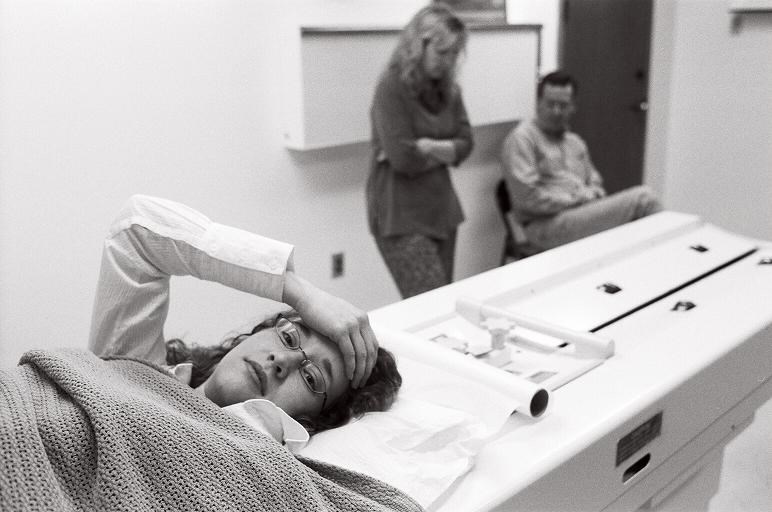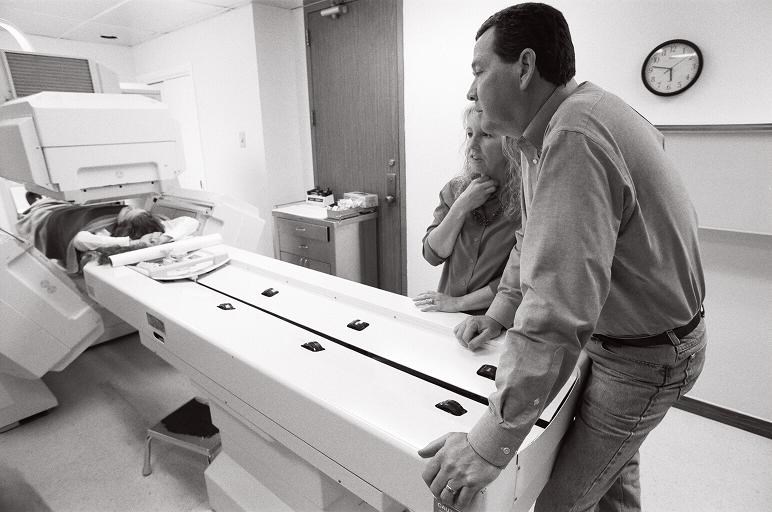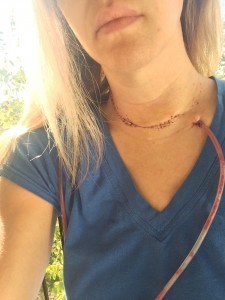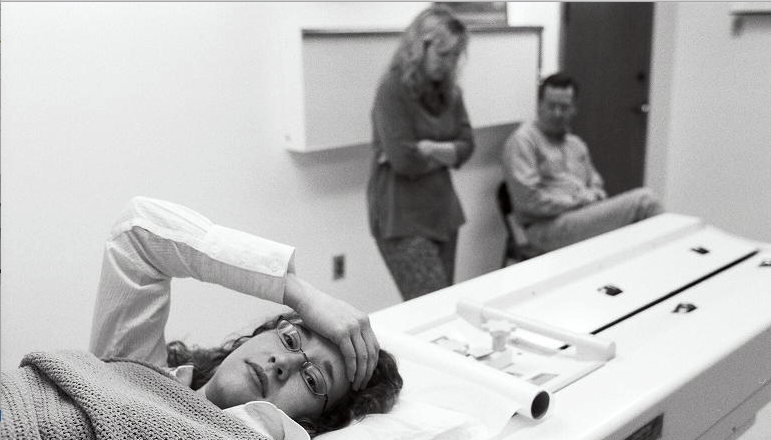
Ten years ago I was diagnosed with thyroid cancer, a 25 year-old, non-smoker, non-drinker having no family history of thyroid disease. I was a full-time journalism student pursuing my Master’s degree while working full time as the Assistant Editor at Plano Profile magazine. I was reporting on other people’s stories, while all along, my own story was unfolding before me.
The paper-thin gown was unforgiving, as I lay cold and vulnerable on my OBGYN’s table. Dr. Jeanelle Kious was to do a thorough well-woman exam and that was all. I was to be back at the office in an hour. So I thought.
“What’s this? I feel a lump,” she said, pressing on the right side of my neck.
“Huh, I have no idea.”
Thursday, Dec. 22, 2005, I met Dr. Kevin Lunde, an Otolaryngologist adjacent to Baylor Scott & White Health in Plano. An ultrasound revealed a 2-centimeter nodule invading my right thyroid gland. The thyroid, he explained, is shaped like a butterfly at the front baseline of your neck. It lies beneath your voice box and consists of two types of cells: follicular cells, which produce a hormone that affects your heart rate, body temperature and energy levels; and C cells, which make calcitonin, a hormone that controls calcium levels in your blood. After the short biology lesson, Dr. Lunde used a fine needle to pierce the protruding mass and extract some tissue to send to pathology.
Surgery was scheduled for Friday, Jan. 20, 2006.
You don’t ever forget where you are when you are told you have cancer. You don’t ever forget the faces of your loved ones standing nearby.
“How did everything go?” I mumbled, half asleep, but sensing my parents nearby.
“It was cancer,” said Dad, staring out the window. Defeated.
There were no words. I had become one of 30,180 people in the United States that year diagnosed with thyroid cancer. Papillary Thyroid Carcinoma to be exact.
“If you’re going to have cancer, thyroid cancer is the best type of cancer to have,” said Dr. Lunde.
‘Best’ wasn’t good enough.
Just when I thought the worst was over, Dr. Lunde removed the drainage tube from my chest. In one pull, every possible definition of pain – throbbing, pinching, stinging – surged through my body from head to toe. I felt as if I was suffocating. My hands locked and my face numbed. Mom rubbed ice on my lips and with one swallow of the cold crunchy slush, my senses snapped back in place.
Two days after the bandages were removed, my scar accidentally revealed itself. Yes, accidentally. A thick, 4-inch pink blemish front and center on your neck is not exactly avoidable. I was devastated and it was only the beginning.
For three weeks, I followed a low-iodine diet: no dairy, no white bread, no seafood, no eggs, no chocolate. Basically, I lived on bland oatmeal and green beans to flush my system of any leftover iodine-enriched thyroid cells, to prepare for an upcoming radioactive iodine scan (RAI). This scan would determine whether the thyroid cancer had spread.
Every morning, fear inched its way closer to my psyche and by the third week, it consumed me.
“What if the RAI damages my ovaries and I can’t have kids? What if the cancer spread into my lungs? What if this is the end?”
Dr. Theodore Simon was the nuclear scientist who administered the radioactive iodine pill on Friday, Feb. 10, 2006. While waiting in a room the size of a closet, I felt uneasy and claustrophobic; my mind was racing. Finally, he stepped into the room wearing a white lab coat and thick protective gloves, and he was holding a heavy, insulated capsule the size of a thermos. He carefully presented the capsule to me and explained that the single pill inside would act as an x-rayed magnet in my body. To protect others, I would have to seclude myself for three days. His chemist slowly unscrewed the capsule and this tiny yet significant pill sat sealed in a plastic tube. The chemist told me not to touch the pill with my hands but to suck it straight from the tube.
“I can’t touch it with my hands, yet it’s going inside of my body?”
I sucked down the blue pill and Dr. Simon said jokingly, “Now, you’re hot!”
The fear of the unknown revealed itself six days later. Pam, the nuclear imaging technician, guided me through the scanning process. My parents were allowed in the room as well.
“They won’t be exposed to anything?” I asked.
“Sweetheart, the radioactivity is in you,” said Pam. “They have nothing to worry about.”

I lay stiff for two hours as the scanner encompassed my body. The background music tried its best to calm my nerves but the whole experience was exasperating. Three “concern areas” lit up on Pam’s screen. The radioactive iodine hadn’t yet attacked those. You see, thyroid cells are the only cells in your body that absorb iodine. So any residual cancer cells or tissue left in me lit up on Pamʼs screen because those abnormal cells sucked up the radioactive iodine from that pill. These “concern areas” would be monitored through future blood work and an additional scan next year. For the rest of my life, every day, I would take Synthroid, a thyroid hormone replacement pill.
___
That was 10 years ago. My thyroid cancer is back. Or, had it always lurked around? I’m back in Dr. Lunde’s office talking about a second surgery in my near future. I thought I was cancer-free. I had undergone radiation therapy four times since 2006 and the latest body scan on December 4, 2009 put me in the clear. I thought my fight was over. I’m 35 now. I’m the new Managing Editor at Plano Profile magazine, I have two beautiful babies, a new house on the way, a long future…But recent blood work and ultrasounds showed alarming regrowth.
Another fine needle biopsy was done. I knew the routine. I lay on my back with a white towel propped behind my shoulders so that my neck was stretched taut and my chin was protruding in the air. The 4-inch needle coming at me made its way closer to my flesh and I felt the swelling warmth of tears break from their hiding place. Yes, I felt the pinch. The sting. The tickling awkwardness of wet streams trailing down into my ears. The burning envy in my gut.
“Why me?”
My sweet husband looked on wishing he could help. Through this whole ordeal, from his perspective, Pain was not the principal character, rather the plot thickener. Hope was his protagonist and raw physical Pain only emerged in tight hand squeezes. Tears that accompanied biopsies, blood work and doctor’s appointments, were lingering evidence of Pain’s intrusion.
“Why her?”

Surgery was early Thursday morning, October 8, 2015. Arm-in-arm, my husband and I walked into Baylor Scott & White Health in Plano. A total of 31 lymph nodes were removed and three were cancerous, the largest mass measuring 1.4 centimeters. Nerves were obviously damaged in the process, leaving the middle, right side of my neck permanently numb. Two long drain tubes inserted on either side of a 6-inch scar were keeping the swelling and infection down. For the next week, I monitored their blood production output levels and notified the doctor of the results. I will have blood work done every three to six months to monitor my thyroid hormone levels and I will continue taking Synthroid every day for the rest of my life.
Until I got it, I never knew that thyroid cancer was the most common endocrine cancer. The American Cancer Society estimates that there will be about 62,450 new cases of thyroid cancer in the U.S. in 2015. Of these new cases, about 47,230 will occur in women and about 15,220 will occur in men. About 1,950 people will die of the disease this year.
People say that cancer is like a brick wall and there’s no breaking through it. But I’ve learned in these last 10 years that my brick wall was meant for climbing. Family and friends are my footholds. Mom is my biggest cheerleader. When the wind shakes me, I keep climbing because I know that falling won’t be the end of me. That’s the only way I know how to keep climbing–knowing that the fall won’t be the end.
In each of our journeys, we all experience dark places of pain, fear and grief, but those places are not dead ends; we are not meant to anchor down in them. We are meant to use them as passageways to find hope, healing and peace. We sail on; we climb on; we carry on, and we anticipate the miracle awaiting us on the other side.
I would love to hear your story. It doesn’t have to be one of cancer. Maybe you’ve gone through a trial that you thought would never happen to you. Please share your story (and your “scarfie”) to inspire others! Email me at [email protected].
Photos (2006) by Don Jones




